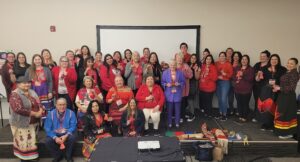Anishinabek Nation hosts successful Family Violence Prevention Conference

By Victoria Racette and Laura Barrios
NORTH BAY – The Anishinabek Nation Social Development Department organized and hosted its first Family Violence Prevention Conference from April 9-10, 2024, at the Grand Event Centre in North Bay, Ontario.
The Conference opened in a good way with Nipissing First Nation Elder Mike Couchie leading a Pipe Ceremony.
“We’re gathering in a good way to realize the importance of [Family Violence Prevention], to see the strength, beauty, and kindness we have as Anishinaabe people, [and] to replace violence with kindness. So that the families [frontline workers] work with can stand up and take care of themselves and their families,” said Elder Couchie during his remarks.
Over the course of the two-day Conference, participants identified priorities for family violence prevention, were introduced to star teachings – constellations and clans-bagone-giizhig (the hole in the sky) led by Joseph Sutherland (Mishkiki), and held in-depth discussions during a comprehensive exercise to answer key questions.
“Our communities are struggling like you wouldn’t believe,” shared one participant. “I’m here to capture whatever I can that [will] provide for [children] to remain at home and enable families to continue caring for their children and access the services that are needed for them.”
“…in some of our communities it’s been a long time since we’ve really tackled this issue – family violence. It’s in a dire spot,” expressed Elder Couchie.
Discussions held during the Conference identified that learning and working together to overcome the long-standing challenges within the communities will be critical in beginning to heal, build and rebuild, and break the cycles that exist within the Nations.
“I’m hoping we can share collectively, to figure out new and innovative ways to work with our families. We need to have a good understanding of the environment and challenges our children are faced with today,” shared another participant.
Throughout the Conference, there were several networking opportunities for participants to connect with others to explore challenges, successes, goals, or simply share a meal and connect with fellow frontline workers.
“[We must] promote family kindness,” added a participant. “So that we can give our Nations, clans, communities, and families an opportunity to heal. Because of colonization, our ways of being have been altered. There is a lot of knowledge for us to pick up.”
The Conference featured traditional teachings by Elder Couchie and Evelyn McLeod, an Elder from Nipissing First Nation, as well as a workshop led by Jared BigCanoe (Mishkiki) entitled, Madoodiswan: Teachings About Sweat Lodge Building and Ceremony Workshop.

The Conference also hosted artist Katie Laronde, who graphically recorded the two-day event as participants navigated through discussion questions focused on the safety measures currently in their community and what else is needed, ways to increase community engagement, how to overcome barriers faced in community, how cultural teachings apply to family violence prevention, and how safe participants feel within their community and greater society.
“Preventing family violence in our communities brings significant impacts that are crucial for their well-being and development. It not only mitigates immediate harms, but also fosters long-term benefits such as cultural preservation, intergenerational knowledge transfer, community cohesion, nationhood development, and individual empowerment,” said organizer and Anishinabek Nation MMIWG Policy Analyst Rebecca Timms. “These events promote creating a network of supports that can help address challenges and provide a platform for collective action – essential for creating safer, healthier, and more vibrant First Nation communities.”


